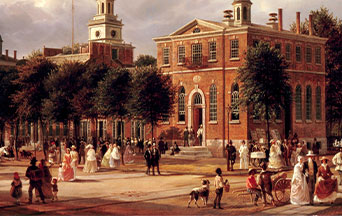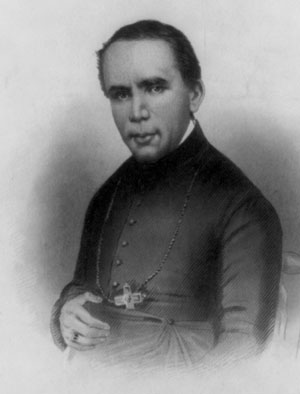
In August 1851, Pope Pius IX elevated Bishop Francis Kenrick from the Diocese of Philadelphia to the Archdiocese of Baltimore. Upon arrival, the new archbishop began going to Father Neumann for confession. The two men were acquainted, but the archbishop grew increasingly impressed with the immigrant priest’s intelligence, ability and energy. When Pope Pius IX asked Archbishop Kenrick to list qualified candidates for the See of Philadelphia, Archbishop Kenrick mentioned John Nepomucene Neumann.
Father Neumann did not know of this development. When he finally heard, he was appalled. He had no desire to be a bishop anywhere, still less in a metropolis like Philadelphia. Nonetheless, the Pope appointed him, insisting that Father Neumann’s vow of obedience forced acquiescence.
Why America Must Reject Isolationism and Its Dangers
On March 28, 1852, Archbishop Kenrick consecrated him as the fourth bishop of Philadelphia.
An Active Shepherd
During his eight years (1852-1860) in office, Bishop John Neumann built eighty-nine churches, set up the first modern Catholic school system and introduced the Forty Hours Devotion.

In 1852, Philadelphia was an immense diocese comprising 35,000 square miles. It included what is now the Archdiocese of Philadelphia, the dioceses of Trenton (New Jersey) and Wilmington (Delaware), and the Pennsylvania dioceses of Harrisburg, Scranton, Allentown and part of Altoona. Over a million people lived in this vast area, including 170,000 Catholics. There were 92 Churches, eight chapels, 101 priests, 43 seminarians and two Catholic colleges.
The new bishop lost no time getting “settled in.” Instead, he called on parishes the very day he arrived, March 30, 1852. He visited every city parish at least once a year and every parish in the outlying areas every two years. It was a punishing schedule, but the uncertainties of travel in the 1850s were nothing new to him.
An Act of Consolation and Conversion
Nor did Bishop Neumann limit his attention to his scattered flock. In his 1976 book, The History of the Archdiocese of Philadelphia, Monsignor James F. Connolly records a story from Bishop Neumann’s first week in the city when he visited the local jail.
“The Stuprinski brothers, condemned to death for the murder of a boy, had steadfastly refused to manifest repentance and see a priest, but Neumann won them over; they agreed to make their peace with God and receive help from the priest before they went to their death.”
Today, the noose and black hood used in the executions form a rather startling display in the museum devoted to Saint John Neumann’s life in Philadelphia.
Bringing the Sacraments to the Isolated
Of course, much of his attention focused on the needs of German-speaking immigrants. This preference was not the fruit of misplaced German nationalism but rather that these immigrants’ unmet needs cried out loudest. A common phrase in ecclesiastical circles of the time was, “Language saves Faith.” Indeed, a pastor needs to be able to speak to the members of his parish. One factor that made Bishop Neumann ideal for his job was his command of several languages. German and Czech were the languages of his home. Latin he learned from childhood. Over his lifetime, he acquired fluency in French, Italian, English, Spanish and Gaelic.
Eternal and Natural Law: The Foundation of Morals and Law
Bishop Neumann was devoted to the sacramental life of his flock. Monsignor Connolly relates an anecdote that illustrates that quality.
“At Bellefonte, he learned of a family living in a lonely settlement at Snow Shoe with a son who had not yet been confirmed. It was pointed out to the bishop that the journey was long and that the road was steep and rough in the Allegheny Mountains, but he and the pastor, Father Otto Kopf, O.S.B., traveled twenty-five miles, a trip that took them from early morning until evening, to administer Confirmation to one person.”
Forty Hours’ Devotion
Perhaps the best example of Bishop Neumann’s leadership was his promotion of the Forty Hours’ Devotion. Indeed, the devotion was nothing new. Saint Charles Borromeo (1538-1584) described it as an ancient practice. Even some Pennsylvania parishes had some form of it before Bishop Neumann’s arrival. However, the bishop had something more significant in mind. To him, the Forty Hours was a way to tie the diocese together while binding it more closely to Rome.
As with all Godly inspirations, the idea had ecclesiastical detractors. They argued that an evident devotion to the Holy Eucharist would excite anti-Catholic passions. Some misguided Protestants might even commit desecrations against the Body of Our Lord as He reposed in the monstrance.
Then, an astonishing incident occurred. Father Bonafacius Wimmer, a German Benedictine monk in Latrobe, Pennsylvania, described it.
“The Bishop was working in his room one night when he fell asleep. His candle burned down to the point that it charred the papers on the table. Astonished that the papers did not burn, the bishop fell to his knees. He thought he heard the voice of God tell him, ‘As the flames are burning here without consuming or injuring the writing, so shall I pour out my grace in the Blessed Sacrament without prejudice to My honor. Fear no profanation, therefore; hesitate no longer to carry out your design for My glory.’”
 Learn All About the Prophecies of Our Lady of Good Success About Our Times
Learn All About the Prophecies of Our Lady of Good Success About Our Times
Instantly, the bishop devised a schedule for the diocese’s various parishes. He also composed a booklet on the rites to be observed. At his request, Rome extended special indulgences to those attending. The devotion proved so popular that it extended to neighboring areas.
To Rome and Home
Perhaps the high point of John Neumann’s life came with the Pope’s invitation to Rome to attend the Solemn Declaration of the Immaculate Conception on December 8, 1854. After a couple of months in Rome, he returned to his childhood home in Bohemia, where he visited with his widowed father, sisters, and many old friends and seminary classmates.
Another red-letter day was September 13, 1858, when the exterior of Philadelphia’s Cathedral Basilica of Saints Peter and Paul, whose construction had been inaugurated by Bishop Kenrick, was completed. Unfortunately, Bishop Neumann would not live to see the interior completed.
On January 5, 1860, the bishop visited a local bank to attend to some necessary business, even though he did not feel well. He collapsed as he walked back to his home in Logan Square. Helped to the comfort of a nearby private home, he died there at 3:00 in the afternoon at the age of 49. On January 10, 1860, he was buried in the crypt of Saint Peter’s Church in Philadelphia.
A Magnificent Example
Archbishop Kenrick delivered a magnificent funeral oration. Given the length of this article, a couple of passages must suffice.
“Brethren, it may be a matter of surprise, as it is of regret, that so holy a prelate should be so suddenly snatched out of life, without a moment’s warning save some symptoms which, although strange, did not excite alarm…. But what matters it, brethren? He was prepared to die at any moment, for he lived by faith and walked with God. Each year of his life, he passed ten days in retreat preparing for death; each month, he observed a day of special recollection in the same spirit; each morning, he meditated on heavenly things; each hour, and almost each moment, his soul communed with God. The death of such a man could not be unhappy.”
10 Razones Por las Cuales el “Matrimonio” Homosexual es Dañino y tiene que Ser Desaprobado
Indeed, Bishop Neumann’s impact on the diocese and his holiness were evident. On December 11, 1921, Pope Pius XI declared him venerable. That was followed by beatification on October 13, 1963. Pope Paul VI canonized him on June 19, 1977.
(This article is the fourth of the author’s five articles about the life of Saint John Neumann. Read the first article here, the second here, the third one here, and the fifth here. The Editor)

